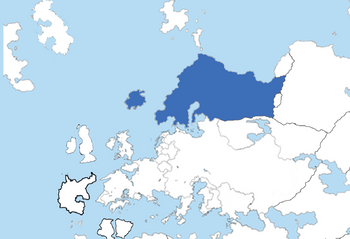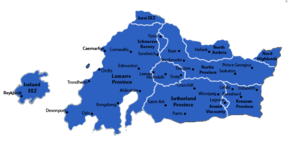Erebonian Empire: Difference between revisions
No edit summary |
No edit summary |
||
| (2 intermediate revisions by the same user not shown) | |||
| Line 34: | Line 34: | ||
|government_type = Unitary parliamentary constitutional monarchy | |government_type = Unitary parliamentary constitutional monarchy | ||
|leader_title1 = Monarch | |leader_title1 = Monarch | ||
|leader_name1 = [[Eugent | |leader_name1 = [[Eugent Reize Arnor III]] | ||
|leader_title2 = Prime Minister | |leader_title2 = Prime Minister | ||
|leader_name2 = [[Giliath Osbourne]] | |leader_name2 = [[Giliath Osbourne]] | ||
| Line 115: | Line 115: | ||
}} | }} | ||
'''Erebonian Empire''' , officially the '''Imperial Nation of Erebonia''' is a sovereign country in Western [[Zemuria]]. It neighbors the [[Nordic Islands Federation]] to the north; the [[Crossbell State]] and [[Calvard|Calvard Republic]] to the west; and [[Alteria]] to the north. | '''Erebonian Empire''' , officially the '''Imperial Nation of Erebonia''' is a sovereign country in Western [[Zemuria]]. It neighbors the [[Nordic Islands Federation]] to the north; the [[Crossbell Free State]] and [[Republic of Calvard|Calvard Republic]] to the west; and [[Alteria]] to the north. | ||
During the 17th to the 19th Century, the country had been a loose confederation of Nordic and German-speaking duchies, provinces, and mountain regions. In 1743, King [[Valius the Great|Valius Reise Arnor III]] of Erebonia launched a series of massive campaigns that unified the Provinces of Lamarre, Albarea, Kreuzen, Nortia, Crossbell and the Sutherland Province, along with the Viscounty and Baronies of Arseid and Schwarzer to form the modern Erebonian Empire. Since 1783, the Erebonian Empire and the [[Calvard|Calvard Republic]] had been at war over the occupancy of the [[Crossbell State]]. The two nations settled their disputes in several wars starting from the [[Erebonian-Calvardian Wars of 1785]], [[Erebonian-Calvardian Wars of 1787-1791|1787-1797]], [[Erebonian-Calvardian Wars of 1791-1815|1791-1815]], [[Erebonian-Calvardian Wars of 1840-1875|1840-1875]], [[Erebonian-Calvardian Wars of 1883-1901|1883-1901]], the [[First Europan War|First]] and [[Second Europan War]]s, the [[War of Lorican Aggression]], and the present [[Imperial Crisis]]. In 1850, the [[Erebonian Navy]] provoked the [[Royal Navy]] stationed at the Erebonian island of [[Iceland (EE)|Iceland]] under suspicions that the [[Lucis Empire]] was preparing to invade its colony of Iceland. The [[Lucis-Erebonian Wars of 1850-1858]] sparked with the Lucian land troops landing and occupying Iceland and invaded the mainland itself. Outnumbering the Erebonian Forces, the Lucis Army occupied the stretches from the [[Tyhhrenian Plateau]], the [[Lamarre Province]], a portion of the [[Sutherland Province]], to the [[Aragon Mountain Range]]. The [[Treaty of Kongsberg]] was signed, ending the war with the occupied portions of Erebonia remaining under Lucis Sovereignty under the name [[Western Erebonia|Dominion of Erebonia]]. With the [[Dominion of Alteria]], the two dominions established Lucian presence and culture in Zemuria. In 1920, Western Erebonia was returned to the mainland with all Lucis forces and government officials leaving the region and with Alteria being granted indepdence. | During the 17th to the 19th Century, the country had been a loose confederation of Nordic and German-speaking duchies, provinces, and mountain regions. In 1743, King [[Valius the Great|Valius Reise Arnor III]] of Erebonia launched a series of massive campaigns that unified the Provinces of Lamarre, Albarea, Kreuzen, Nortia, Crossbell and the Sutherland Province, along with the Viscounty and Baronies of Arseid and Schwarzer to form the modern Erebonian Empire. Since 1783, the Erebonian Empire and the [[Calvard|Calvard Republic]] had been at war over the occupancy of the [[Crossbell State]]. The two nations settled their disputes in several wars starting from the [[Erebonian-Calvardian Wars of 1785]], [[Erebonian-Calvardian Wars of 1787-1791|1787-1797]], [[Erebonian-Calvardian Wars of 1791-1815|1791-1815]], [[Erebonian-Calvardian Wars of 1840-1875|1840-1875]], [[Erebonian-Calvardian Wars of 1883-1901|1883-1901]], the [[First Europan War|First]] and [[Second Europan War]]s, the [[War of Lorican Aggression]], and the present [[Imperial Crisis]]. In 1850, the [[Erebonian Navy]] provoked the [[Royal Navy]] stationed at the Erebonian island of [[Iceland (EE)|Iceland]] under suspicions that the [[Lucis Empire]] was preparing to invade its colony of Iceland. The [[Lucis-Erebonian Wars of 1850-1858]] sparked with the Lucian land troops landing and occupying Iceland and invaded the mainland itself. Outnumbering the Erebonian Forces, the Lucis Army occupied the stretches from the [[Tyhhrenian Plateau]], the [[Lamarre Province]], a portion of the [[Sutherland Province]], to the [[Aragon Mountain Range]]. The [[Treaty of Kongsberg]] was signed, ending the war with the occupied portions of Erebonia remaining under Lucis Sovereignty under the name [[Western Erebonia|Dominion of Erebonia]]. With the [[Dominion of Alteria]], the two dominions established Lucian presence and culture in Zemuria. In 1920, Western Erebonia was returned to the mainland with all Lucis forces and government officials leaving the region and with Alteria being granted indepdence. | ||
| Line 124: | Line 124: | ||
==Etymology== | ==Etymology== | ||
The first mention of Erebonia came during the year 100 B.C. in the reign of [[Dath'Remar]]. During his conquest of Zemuria, he had noticed the region around the land was shrouded in darkness. In which the sunlight rarely ever shined on the region. In the records, Dath'Remar noted the region's often cloudy skies and frequent rains throughout the year. In his diaries, he mentioned that "The land might have suited the residence of {{wp|Erebus}}, the deity of darkness.". He later on gave the name '''Erebona''' to the land in reference to the deity. | |||
The Lucio-Saxons of Lucis referred to the Kingdom of Erebona as ''"Erebonna Land"'' in 880. | |||
Following Erebonia's Christianisation, the term '''"Erebonia"''' became more common. Several manuscripts have survived from the 15th Century that bore witness to the Christianisation of Erebonia. | |||
==History== | ==History== | ||
| Line 130: | Line 136: | ||
[[File:Erebonia2.png|thumb|left|Major cities and the provinces of the Erebonian Empire]] | [[File:Erebonia2.png|thumb|left|Major cities and the provinces of the Erebonian Empire]] | ||
==Dependencies== | ==Dependencies== | ||
Latest revision as of 13:33, 22 January 2022
This article is incomplete because it is pending further input from participants, or it is a work-in-progress by one author. Please comment on this article's talk page to share your input, comments and questions. Note: To contribute to this article, you may need to seek help from the author(s) of this page. |
Imperial Nation of Erebonia Kaiserlich Nation von Erebonia (Erebonian) Kejserlig Stat i Erebonia (Jutlandish) Kejserlig län av Erebonia (Gimlian) | |
|---|---|
| Motto: Vom Land Zum Meer (From Land to Sea) | |
| Anthem: Imperial Psalm | |
 | |
| Capital | Heimdall |
| Largest city | Kongsberg |
| Official languages | Erebonian, English |
| Recognised national languages | Jutlandish, Gimlian |
| Demonym(s) | Erebonian |
| Government | Unitary parliamentary constitutional monarchy |
• Monarch | Eugent Reize Arnor III |
• Prime Minister | Giliath Osbourne |
| Legislature | Parliament |
| Upper House | |
| House of Commons | |
| Formation | |
• Constitution Act 999 | 18 March 999 (1809) |
• Heimdall Act | 3 March 1110 (1920) |
• Independence of West and North Erebonia from the United Kingdom | 15 May 1110 (1920) |
| Area | |
• | 698,700 km2 (269,800 sq mi) |
| Population | |
• X941 (2015) estimate | 52,929,326 |
• Census | 52,929,326 |
| GDP (PPP) | estimate |
• Total | 41.078 krone (33.047 Gil) |
• Per capita | 41,151.87 |
| Gini | 26.5 low |
| HDI (2013) | very high |
| Currency | Erebonian Mira (ERM) (K) |
| Date format | dd/mm/yyyy |
| Driving side | left |
| Calling code | +81 |
| ISO 3166 code | ER |
| Internet TLD | .er |
Erebonian Empire , officially the Imperial Nation of Erebonia is a sovereign country in Western Zemuria. It neighbors the Nordic Islands Federation to the north; the Crossbell Free State and Calvard Republic to the west; and Alteria to the north.
During the 17th to the 19th Century, the country had been a loose confederation of Nordic and German-speaking duchies, provinces, and mountain regions. In 1743, King Valius Reise Arnor III of Erebonia launched a series of massive campaigns that unified the Provinces of Lamarre, Albarea, Kreuzen, Nortia, Crossbell and the Sutherland Province, along with the Viscounty and Baronies of Arseid and Schwarzer to form the modern Erebonian Empire. Since 1783, the Erebonian Empire and the Calvard Republic had been at war over the occupancy of the Crossbell State. The two nations settled their disputes in several wars starting from the Erebonian-Calvardian Wars of 1785, 1787-1797, 1791-1815, 1840-1875, 1883-1901, the First and Second Europan Wars, the War of Lorican Aggression, and the present Imperial Crisis. In 1850, the Erebonian Navy provoked the Royal Navy stationed at the Erebonian island of Iceland under suspicions that the Lucis Empire was preparing to invade its colony of Iceland. The Lucis-Erebonian Wars of 1850-1858 sparked with the Lucian land troops landing and occupying Iceland and invaded the mainland itself. Outnumbering the Erebonian Forces, the Lucis Army occupied the stretches from the Tyhhrenian Plateau, the Lamarre Province, a portion of the Sutherland Province, to the Aragon Mountain Range. The Treaty of Kongsberg was signed, ending the war with the occupied portions of Erebonia remaining under Lucis Sovereignty under the name Dominion of Erebonia. With the Dominion of Alteria, the two dominions established Lucian presence and culture in Zemuria. In 1920, Western Erebonia was returned to the mainland with all Lucis forces and government officials leaving the region and with Alteria being granted indepdence.
What came of the occupation was the development of the Erebonian Empire as one of the leading English-speaking countries in Zemuria with its western citizens inheriting the Western Erebonian English tongue, which is totally derived from the Lucian English whilst the remainder of the country possessed their own variation of the English language, forming the Erebonian English.
Being multi-cultured and falling under the Luciosphere, Erebonia has a rich culture, possessing the 6th largest economy behind Gallia-Bruhl, and having the highest quality of life in Zemuria. The Erebonian Empire is a member of the Commonwealth of Nations and the International Red Cross Association.
Etymology
The first mention of Erebonia came during the year 100 B.C. in the reign of Dath'Remar. During his conquest of Zemuria, he had noticed the region around the land was shrouded in darkness. In which the sunlight rarely ever shined on the region. In the records, Dath'Remar noted the region's often cloudy skies and frequent rains throughout the year. In his diaries, he mentioned that "The land might have suited the residence of Erebus, the deity of darkness.". He later on gave the name Erebona to the land in reference to the deity.
The Lucio-Saxons of Lucis referred to the Kingdom of Erebona as "Erebonna Land" in 880.
Following Erebonia's Christianisation, the term "Erebonia" became more common. Several manuscripts have survived from the 15th Century that bore witness to the Christianisation of Erebonia.
History
Geography
Dependencies
Policies
Government
State and territories
Devolved administrations
Law and criminal justice
Foreign relations
Military
Economy
Demographics
Template:Largest Cities in the Erebonian Empire


